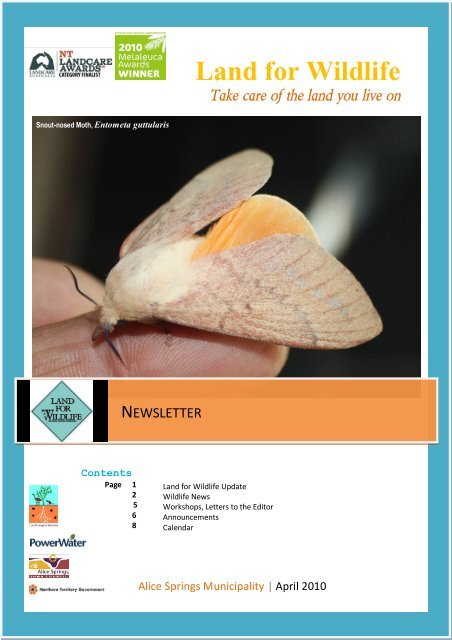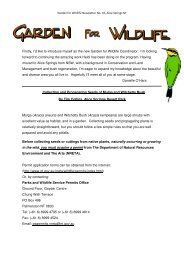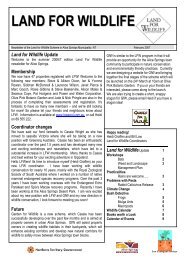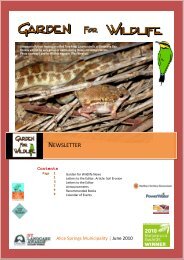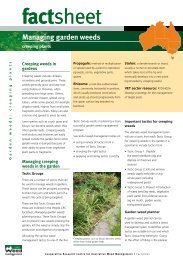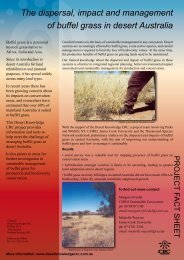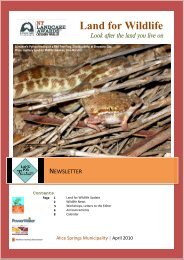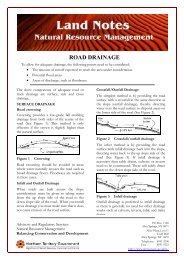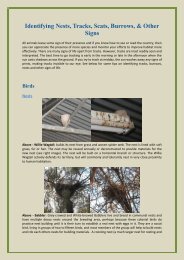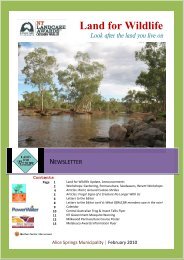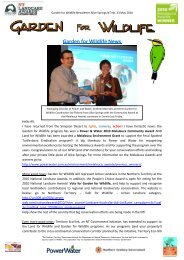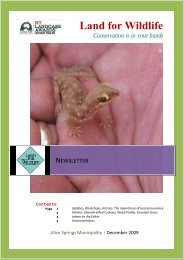Pest Profile - Low Ecological Services
Pest Profile - Low Ecological Services
Pest Profile - Low Ecological Services
You also want an ePaper? Increase the reach of your titles
YUMPU automatically turns print PDFs into web optimized ePapers that Google loves.
Snout-nosed Moth, Entometa guttularis<br />
Contents<br />
Page 1<br />
2<br />
5<br />
6<br />
8<br />
[Type text]<br />
NEWSLETTER<br />
Land for Wildlife<br />
Take care of the land you live on<br />
Land for Wildlife Update<br />
Wildlife News<br />
Workshops, Letters to the Editor<br />
Announcements<br />
Calendar<br />
Alice Springs Municipality | April 2010
Land for Wildlife Update<br />
Managing Director of Power and Water, Andrew Macrides, presents Garden<br />
for Wildlife Coordinator Ilse Pickerd from Alice Springs with the Community<br />
Award at the Melaleuca Awards ceremony in Darwin last Friday.<br />
Hello All,<br />
I have returned from the Simpson Desert to lights,<br />
cameras, action! I have fantastic news: the Garden for<br />
Wildlife program has won a Power & Water 2010<br />
Melaleuca Community Award AND Land for Wildlife has<br />
been awarded a Melaleuca Environment Grant to<br />
support the Feral Spotted Turtle-dove Eradication<br />
program!! A big thankyou to Power and Water for<br />
recognising environmental excellence by hosting the<br />
Melaleuca Awards, and for supporting the program over<br />
the years. Congratulations to all our LfW and GfW<br />
members for your conservation efforts and looking after<br />
your private little piece of Alice Springs. For more<br />
information on the Melaleuca Awards and winners go to:<br />
http://www.powerwater.com.au/environment/melaleuca_aw<br />
ards/previous_winners/.<br />
More good news: As you may remember last year Land for<br />
Wildlife was a finalist for the Community Group NT<br />
Landcare Award, and Garden for Wildlife won the NT<br />
Urban Landcare Award. Garden for Wildlife‟s win has led<br />
the program to be a Finalist for the 2010 National<br />
Landcare Awards, and will represent Urban Landcare in<br />
the Northern Territory at the Ceremony in June. Fingers<br />
crossed!<br />
In addition, the People's Choice Award is open for voting<br />
for the 2010 National Landcare Awards! Vote for Garden<br />
for Wildlife, and help to support and recognise local<br />
landholders contributions to regional and national<br />
biodiversity conservation. The website is below: go to<br />
Northern Territory – „Gdn for Wildlife‟ - Urban Landcare<br />
category.<br />
Land for Wildlife News, Alice Springs, February 2010<br />
http://svc009.wic050p.serverweb.com/nationalawards2010/?utm_source=Landcare+Au<br />
stralia+Ltd+List&utm_campaign=c6c7caaf3e-<br />
Landlink_June_2010&utm_medium=email<br />
Help show the rest of the country that big conservation<br />
efforts are being made in the NT!<br />
Even more good news: Territory Eco-link, an NT<br />
Government initiative, has extended its support to the Land<br />
for Wildlife and Garden for Wildlife programs. As our<br />
programs (and your property!) contribute to the crosscontinental<br />
conservation corridor planned by the initiative,<br />
Territory Eco-link has dedicated $30, 000 a year to the<br />
program over a three-year period! For more information on<br />
Territory Eco-link see:<br />
http://www.greeningnt.nt.gov.au/ecolinks/eco.html.<br />
Are strange things popping up in<br />
your yard with all this rain?! If you<br />
would like anything identified and<br />
explained send us a photo or give<br />
us a ring! We are always happy to<br />
help shed some light:<br />
lfw@lowecol.com.au/8955 5222.<br />
Let me know if you would like to<br />
borrow a feral Spotted Turtle-dove<br />
trap and participate in some backyard trapping. With some<br />
recent trap construction, we now have five traps in<br />
circulation and the wait is not too long!<br />
8955 5222/lfw@lowecol.com.au.<br />
The next Land for Wildlife Workshop is focusing on Soil<br />
Erosion. If you have minor or major erosion on your<br />
property keep this Saturday the 19 th of June free and come<br />
and learn how to identify, rehabilitate and prevent erosion!<br />
Please see the „Workshop‟ section for more details.<br />
Botanist Boyd Wright who conducted Seedbank Surveys<br />
on Land for Wildlife properties in November last year to<br />
look at the effects of the presence and removal of Buffel<br />
grass on native seedbanks contacted us recently with an<br />
update. Thankyou to all those volunteers that helped him<br />
out. Below is his email:<br />
HI Ilse<br />
Re: the Buffel project, no way am I anywhere near the<br />
analysis phase. Still have to get in and find the seeds from<br />
all the dirt I collected. That’s gonna take months. I also<br />
want to put soil from each of the sites in germination trays<br />
and put them in the desert park nursery, if they have<br />
space. It’s very difficult to pick up daisy seeds using the
flotation seed extraction method, so I want to try to<br />
germinate too. Plus, I’m thinking of doing another round of<br />
sampling on the sites now that we’ve have some rain. It will<br />
be nice to have a pre- and post- rain comparison of the veg<br />
and seed bank. Ill keep you posted on how it’s all going. If<br />
any one wishes to participate in seed work please let me<br />
know. Ok mate, hope you’ve had a good past few months,<br />
how was the light in Broome?<br />
Cheers<br />
Boyd<br />
Ed - Would anyone like to help Boyd out with some seed<br />
work? Please express your interest to us at Land for<br />
Wildlife (lfw@lowecol.com.au) and we will keep you<br />
informed as to when and where he needs vollys!<br />
Thankyou everyone for feedback on Newsletter content<br />
and length. The consensus was that the length is OK! But<br />
I‟ll do my best to keep them concise!<br />
Wildlife News<br />
We have recently had a stunning caterpillar, found cruising<br />
the concrete outside the old Commonwealth Bank near the<br />
ancient River Red Gum on Parsons St, identified by Dr<br />
Michael Braby, Curator of Entomology at the Museum and<br />
Art Gallery (Darwin) NT who was recommended to us by<br />
the Desert Park as a specialist in Butterfly identification.<br />
We had never seen its likes in town before and thought we<br />
were onto something special, but in moth form it is not so<br />
uncommon to us. Probably because the larvae is so well<br />
camouflaged and spends most of its time high up in trees<br />
underneath the bark, it is rarely seen. Luckily the larvae<br />
pupated the next day, its cocoon furry and white, and<br />
emerged in moth form a couple of weeks later later. Below<br />
is the correspondence.<br />
Land for Wildlife News, Alice Springs, February 2010<br />
Snout-nosed Moth caterpillar: around 10cm long! The head is to<br />
the left of both pictures, the picture on the right demonstrates the<br />
two spikes behind the head, and the two blue collar stripes evident<br />
during movement.<br />
Dear Ilse<br />
Thanks for your pics of the caterpillar. The larva is a snout<br />
moth, Entometa (Lasiocampidae). They usually feed on<br />
eucalypt leaves. The only species I am aware of that has<br />
been recorded from the NT is the Boxtree Moth Entometa<br />
guttularis.<br />
Kind regards<br />
Michael<br />
Patrick Honan,<br />
Invertebrate Specialist at<br />
Melbourne Zoo adds:<br />
These caterpillars have a<br />
fringe of hair down each<br />
side of the body that blurs their outline and leaves no<br />
shadow when sitting on a branch, making them hard to<br />
spot for birds. In fact we have an almost identical version in<br />
Melbourne called Entometa fervens (the Gum Snout Moth)<br />
that feeds on gum leaves, and occurs along the east coast<br />
and in South Australia. They're called Snout Moths as the<br />
adults have a long projection in front of the head, but you'll<br />
rarely if ever see one of these. I hope this helps and that<br />
it's not too late.<br />
Interestingly we have had four Snout Nosed Moths turn up<br />
at the office! Below are some photographs and you can tell<br />
a male from female moth by the length of<br />
its antennae (male‟s antennae are much<br />
longer). And the caterpillar that pupated<br />
emerged and immediately laid about 50<br />
eggs each a mm in diameter and stuck to<br />
the surface of whatever was handy, but in<br />
the wild would have been on the under<br />
surface of Eucalypt leaves.<br />
Male<br />
Grass <strong>Profile</strong>s<br />
Summer rains are known as grass producing rains and<br />
they have done us proud this past summer. Here are two<br />
common examples of native grasses.<br />
Button Grass<br />
Alternative Names: Button grass, Coast button grass,<br />
Eight-day grass, Finger grass, Small Crowsfoot.<br />
Family: Poaceae<br />
Species: Dactyloctenium radulans<br />
Female
Origin: Native to Australia<br />
When you gaze across the bizarrely green transformed<br />
desert landscapes, never fear – it‟s not all Buffel!<br />
Button Grass is everywhere at the moment! It is an<br />
opportunist and has taken advantage of the recent rain to<br />
germinate prolifically. This soft and sprawling grass will<br />
grow to 30cm high, with green leaves that are 2-10cm long.<br />
It prefers to grow in gentle depression in low-lying areas,<br />
and can grow in a range of soils (though commonly found<br />
on calcerous or alluvial soils). It can be found often in<br />
disturbed or trampled areas, and is very recognisable when<br />
it seeds. The seed heads are finger-like branches of 3-10<br />
spikes, and they grow in a windmill shaped arrangement<br />
on the top of a stem. It quickly produces abundant seed –<br />
the recent germination is proof of this! – as it is generally a<br />
short-lived annual and not frost tolerant. In gravelly foot<br />
slopes at the edge of the hills or along creek lines watch for<br />
the similar but slightly taller species, Oxychloris scariosa.<br />
The amount of Button Grass that is around at the moment<br />
is acting as great ground litter, and it will dry off quickly.<br />
Button Grass can be found throughout Australia. It can be<br />
of grazing value, though if cattle consume large amounts it<br />
can result in cyanide or nitrate poisoning!<br />
Woolly Oat Grass<br />
Alternative Names: Leafy Nine Awn.<br />
Family: Poaceae<br />
Species: Enneapogon polyphyllus<br />
Origin: Native to Australia<br />
Land for Wildlife News, Alice Springs, February 2010<br />
This grass has been popping up everywhere. The large<br />
seed bank has been in waiting for a rain event like this one.<br />
Don‟t mistake those young furry seed heads for Buffel<br />
when you‟re out weeding!<br />
With some familiarity it is easily distinguished from Buffel. It<br />
is a much shorter grass, growing 10 – 30 cm tall. It is an<br />
upright grass, with numerous stems. The leaves are<br />
covered in soft fine hairs, and the seed heads are compact<br />
and narrow. Florets are usually white, (but sometimes<br />
purple) and smooth with a tuft of hair at the base (hence<br />
the „Woolly‟-ness). Oat grasses are small widespread<br />
annual or biennial grasses. They respond to rain in any<br />
season, enabling them to grow year-round with adequate<br />
rain. It is an annual or short-lived perennial tussock grass,<br />
and can be a pioneer on disturbed areas. It can persist<br />
without rain, making it a carry-over species (providing food<br />
for livestock in drier months). It is an upland grass, growing<br />
on shallow gravelly, sandy or loamy soils, or on red earths.<br />
Another similar species, E. Cylindricus, can also be found<br />
on limestone soils. Woolly Oat Grass is highly palatable<br />
and nutritious for livestock .<br />
Some Great References for Grasses:<br />
Allan, C., Wilson D., (2006). Central Australian Grass<br />
Guide, Northern Territory Government of Australia.<br />
Native Grass group http://dev.nativegrassgroup.asn.au<br />
Cotton catchment Communities<br />
CRChttp://www.cottoncrc.org.au/content/Industry/Publicati<br />
ons/Weeds/WeedIdentificationTools/Weedsbycommonnam<br />
es/Buttongrass.aspx<br />
If you get stuck, send us a photo of of the general plant<br />
(with a ruler or pen for scale) and the seed heads and we‟ll<br />
help you out.
<strong>Pest</strong> <strong>Profile</strong>: Big-Headed Ants<br />
Alternative Names: Coastal Brown Ant<br />
Species: Pheidole megacephala<br />
Origin: South Africa<br />
Status: Big-Headed Ants are an invasive ant species in<br />
Alice Springs, and their activity may be on the increase<br />
after the recent rainfall. If you have a Big-Headed Ant<br />
infestation and would like more information on eradication<br />
techniques, please contact us.<br />
Natural History:<br />
Big-Headed Ants<br />
like humidity, but<br />
will not tolerate<br />
heavy rainfall or<br />
waterlogged soils.<br />
When it rains ants<br />
will come indoors or<br />
nest up in trees.<br />
The Big-Headed<br />
Ant has four castes<br />
or body forms. The queen form is the egg-layer, and there<br />
may be many queens in a nest. Grub-like larvae emerge<br />
from the eggs and are fed by the workers (the queen<br />
larvae are fed a special diet to ensure development). Once<br />
fully grown, larvae metamorphose, emerging as adults.<br />
Unfertilised eggs produce males and fertilised eggs<br />
produce females. Males are the second largest form to the<br />
queen and are elongated in shape. But the most numerous<br />
forms are the „workers‟. Workers are sterile females and<br />
they care for the young, collect food, and build and defend<br />
the nest. There are two types of workers; the most<br />
numerous type has a small head, the less numerous type<br />
has a large head (hence the name Big-Headed Ant). Large<br />
headed forms defend the colony and are sometimes known<br />
as the „soldier caste‟. Queens and males are rarely seen<br />
Big-Headed Ant foraging trail. Note the two types of workers; one in ten<br />
have larger heads (hence the name „Big-headed‟.<br />
Photo courtesy Rod Cramer.<br />
Land for Wildlife News, Alice Springs, February 2010<br />
outside nest unless walking to a new nest site, not far from<br />
the original site.<br />
Photo: Ilse Pickerd<br />
Impacts: The Big-Headed Ant is spread mainly by human<br />
activity, for example transported in infested pot plants.<br />
Originally from South Africa, the Big-Headed Ant has<br />
spread to many tropical and temperate environments<br />
world-wide. A threat to biodiversity, the invasive ant<br />
dominates habitat, eliminating all native ant species from<br />
the area, as well as other insect species, spiders and<br />
centipedes, and changes vegetation. Big-Headed Ants<br />
impact on the ecological services that native ants supply<br />
such as soil aeration and seed dispersal. They are also a<br />
domestic nuisance, invading kitchens and bathrooms to<br />
feed on food scraps and fine layers of grease. Big-Headed<br />
Ant trails can cause cracks in brickwork and tiles, and once<br />
the ant is inside a house it can nest in light switches,<br />
computers and household appliances. Outside, the ant will<br />
nest at the base of trees and shrubs, disturbing the root<br />
system which can result in the plant‟s death.<br />
Eradication: Amdro® is the most effective ant bait against<br />
Big-Headed Ants and contains the slow-acting insecticide<br />
hydramethylnon. The ants carry the bait into the nest to<br />
feed the brood, which results in exterminating a large<br />
proportion of the colony. However, several treatments may<br />
be needed to eradicate the entire nest, with aim of killing<br />
the queen ants. Hydramethylnon breaks down in sunlight<br />
and is best applied in the afternoon or twilight. It is safe to<br />
use in gardens and around buildings, but must be used in<br />
accordance with the instructions on the manual.<br />
Photo left: Bigheaded<br />
ants are one<br />
of several invasive<br />
ant species in Hawaii<br />
(Hawaii has no<br />
native ants). They<br />
eat native plant<br />
seeds and kill native<br />
insects (for example<br />
Mulga seeds are<br />
stored in seedbanks<br />
of native ants). This<br />
photograph<br />
demonstrates how
Big-Headed Ants can swarm over seabird chicks. They will<br />
attack chicks, eggs and webbing of bird‟s feet. Photo<br />
credit: C. Vanderlip.<br />
Refernces: G. Young. 2000 , the coastal Brown or Bigheaded<br />
Ant, NTgovt<br />
Letters to the Editor<br />
Ilse,<br />
With the burst of activity following the rain and the<br />
imminent arrival of Autumn and Winter, the Lizards are<br />
active.<br />
Now is a good time to check that there are no inadvertent<br />
"traps" for these very curious creatures in your garden.<br />
Make sure that all your empty plant pots, buckets, plastic<br />
bins, even pieces of steel or plastic pipe, are all stored on<br />
their sides so that the Lizards cannot get trapped inside.<br />
Their clever and sharp little claws cannot get purchase on<br />
plastics or metal and a smooth vertical wall of about<br />
200mm or more can easily trap the creatures so that they<br />
die of dehydration and starvation.<br />
All the "big" containers, such as rubbish and re-cycling<br />
bins, can save a Lizard if they have a strip of shade cloth<br />
fixed at the top and draped down inside the bin.<br />
Happy observing of Wildlife,<br />
Dave Leonard<br />
P.S. The Channel Billed Cuckoo flew over yesterday<br />
morning.<br />
This creature was dropped in to the Land for Wildlife office<br />
for identification. It is actually the moult of a freshwater<br />
invertebrate belonging to the Belostomatidae family.<br />
Order: Hemiptera<br />
Suborder: Heteroptera<br />
Superfamily: Nepoidea<br />
Family: Belostomatidae<br />
Species: Lethocerus<br />
Not to be mistaken spp.<br />
for a Water Scorpion - which is the<br />
common name given to the Nepidae family because of<br />
their raptorial forelegs and the presence of a long slender<br />
respiratory siphon at the posterior end of the abdomen,<br />
simulating a tail - the Belostomatidae, who do not have<br />
such a long siphon, are commonly called Giant Water<br />
Bugs. In A Field Guide to Insects in Australia by Paul<br />
Zborowski & Ross Storey this creature is given the<br />
Land for Wildlife News, Alice Springs, February 2010<br />
Photo courtesy Holger Voyt<br />
common name of Fishkiller Bug! A popular food in<br />
Thailand, it is the<br />
largest bug in the<br />
Hemiptera order,<br />
occurring<br />
worldwide in<br />
freshwater streams<br />
and waterholes.<br />
The moult<br />
(photographed<br />
above) measured<br />
7cm long, so the Giant Water Bug that emerged is now<br />
larger! This waterbug is a Lethocerus species, which are<br />
known to exceed 12cm. Fierce predators, the<br />
Belostomatids stalk, capture and feed on aquatic<br />
crustaceans, fish and amphibians. They hunt by using an<br />
ambush or sit-and-wait approach, lying motionless at the<br />
bottom of the water, attached to various objects, until prey<br />
comes near enough to strike. They inject a powerful<br />
digestive saliva into their prey to enable liquefied remains<br />
to be sucked out. Their bite is considered to be painful; the<br />
longer the bug is allowed to inject its saliva, the worse the<br />
resulting bite.<br />
Adults cannot breathe under water, and must surface<br />
periodically to stick their tails into the air which is siphoned<br />
with two short flat retractable respiratory filaments (as<br />
opposed to one long one in Water Scorpions). Adults have<br />
wings allowing them to migrate if water dries up or the wet<br />
season occurs, and will fly at night like many aquatic<br />
insects. They may be attracted to lights during the breeding<br />
season.<br />
Interestingly, care of eggs is paternal, and in Lethocerinae<br />
sub-families eggs are laid on the male‟s wings and he will<br />
carry them around on his back to keep them properly<br />
oxygenated. The male cannot mate during this period and<br />
so invests considerable energy and time in reproduction,<br />
whereas the female takes the role of actively finding mates.<br />
There are all sorts of water bugs cruising in Alice Springs<br />
water holes. You may notice some in any buckets of water<br />
you have in your garden. Water bugs can be used as<br />
indicators of freshwater stream or water body health, as a<br />
method of biological monitoring. This method can provide a<br />
more comprehensive assessment of stream health than<br />
physio-chemical measurements alone as water bugs react<br />
to all different types of impact. A range of water bugs live in<br />
a healthy water body, and presence/absence of species<br />
and level of species richness will indicate if a water body is<br />
in near natural condition or impacted. For more information<br />
on water bugs visit some of the websites below:<br />
Field Guide to Freshwater Invertebrates:<br />
http://www.seanet.com/~leska/Online/Guide.html<br />
Invertebrates in Arid NT Wetlands:<br />
http://www.nt.gov.au/nreta/wildlife/nature/pdf/aridwetlands/i<br />
nvertebrates.pdf
Australian River Assessment System (NRETAS):<br />
http://www.nt.gov.au/nreta/water/aquatic/ausrivas/index.ht<br />
ml<br />
Water Bugs & Water Scorpions, QLD Museum Learning:<br />
http://www.qm.qld.gov.au/~/media/Documents/QMSB/Inqui<br />
ry%20Centre/Fact%20Sheets/water_bugs_20080709.pdf<br />
The grasshoppers are finally abating and your gardens are getting a break<br />
from the munching, and hopefully will get some more rain! Young Wildlifer<br />
Elkin disturbs the masses from the Buffel grass along the Todd River last<br />
month.<br />
Workshops & Seminars<br />
Free Land for Wildlife Workshop<br />
SOIL EROSION & CONSERVATION<br />
Come and learn how to identify, rehabilitate, and<br />
prevent soil erosion with Soil Conservation<br />
Officer Col Stanton.<br />
Saturday 19 th June<br />
9:30am – 12<br />
RSVP: Ilse on 8955 5222,<br />
lfw@lowecol.com.au<br />
The workshop will look at two sites. Meet at the cul<br />
de sac at the end of Lilliecrapp Rd., Ilparpa.<br />
Rangelands Biology & Ecology<br />
Seminars<br />
SPEAKERS and PARTICIPANTS NEEDED.<br />
Volunteer speakers, requests or cancellation of email<br />
notification: contact Bill <strong>Low</strong>, Coordinator, P.O.Box 3130,<br />
Alice Springs; Phone/Fax 89 555 222, Fax 89 555 722;<br />
Email: <strong>Low</strong>Ecol@<strong>Low</strong>Ecol.com.au<br />
Organisational and distributional assistance from CSIRO,<br />
NRETAS, DResources, CAT, CLC, CDU.<br />
Land for Wildlife News, Alice Springs, February 2010<br />
Photo: Oliver Eclipse<br />
Seminar notices are available on:<br />
http://www.cse.csiro.au/news/alicespringsseminars.pdf<br />
Rangeland Biology and Ecology Seminars (broadened<br />
from the former Rangelands Coordinating Committee) have<br />
been useful in facilitating communication between<br />
environmental researchers, technicians, managers,<br />
students and the interested public in Alice Springs since<br />
1974. The seminars provide an opportunity for the diverse<br />
Government, Institutional, Council, Company and private<br />
technical community and interested public to discuss<br />
current research and projects, impacts on or opportunities<br />
in arid Australia. Presenters may provide information on<br />
research and management of biological, landscape,<br />
cultural and physical aspects of central Australia or<br />
pertinent topics from around the World. The seminars also<br />
provide a training arena to practice talks for conferences or<br />
to float ideas or to help develop a project. Sometimes they<br />
present technical travelogues of distant lands. Appropriate<br />
professional society or interest group notices can also be<br />
included. The venue is the one most appropriate for the<br />
speaker and audience. For consistency the venue has<br />
usually been the CSIRO Conference Room, but with<br />
CSIRO‟s move to their new location at the Desert<br />
Knowledge Centre, the CDU venue is currently a good<br />
central location. Come along for a natter, a catch up or to<br />
meet new people and new ideas.<br />
Announcements<br />
Making Windows Safe for Birds<br />
Competition<br />
At the Melaleuca Awards Power & Water kindly gave<br />
us a free Level 1 Water Audit. We would like to give it<br />
to one of our members, and so have designed a<br />
competition to win it!<br />
This is a competition for the best „Bird-proofing of<br />
Windows‟ idea.<br />
Windows are a major contributor to bird deaths<br />
globally. Birds see only the tree reflected in a window, or<br />
the plant behind the window, not the glass itself. To stop<br />
these collisions we need to make glass visible to birds.<br />
What are your tried and tested methods or your<br />
ideas? Email us with your favourite technique at<br />
lfw@lowecol.com.au to win a Power & Water Level<br />
1 Water Audit.<br />
Some websites for inspiration:<br />
http://www.birdsandbuildings.org/problems.html<br />
http://www.flap.org/new/prevent.htm
http://www.buildinggreen.com/auth/article.cfm/2005/8/<br />
1/Design-for-the-Birds-Protecting-Birds-from-the-<br />
Hazards-of-Glass/?&accessCode=%20odynj2<br />
http://www.duncraft.com/Window-Strike-Solutions-<br />
C227.aspx<br />
Power & Water Level 1 Water Audit is an<br />
evaluation of a site’s overall water consumption to<br />
determine whether water use is excessive or<br />
reasonable. The overview provided encourages<br />
water conservation and efficiency, and identifies<br />
water use and costs to enable control measures to<br />
be implemented and reviewed. Financial and<br />
environmental benefits are gained by using water<br />
efficiently, and the Water Audit will help to<br />
determine ways to reduce consumption and<br />
conserve our most important resource in a<br />
country suffering shortages.<br />
Volunteers Needed!<br />
Free entry to the Alice Springs Show will be awarded to<br />
anyone willing to help us for a couple of hours at this<br />
year‟s Land for Wildlife/Garden for Wildlife stall at the<br />
Show! Our stall is shared with the Australian Plants<br />
Society in their gorgeous display garden, conveniently<br />
located next to the Alice Springs Pistol Club‟s Donut<br />
stand! The event is always lots of fun, and great<br />
chance to share garden ideas, learn more about our<br />
local plants and show off our recent award winnings!<br />
We‟d love to see you there. Contact Ilse/Bill on 8955<br />
5222/lfw@lowecol.com.au.<br />
Websites Worth a Look<br />
Flooding Photos:<br />
Impressive photos of flooding from QLD flowing into SA;<br />
Cooper Creek into Strzelecki Creek, and flooding around<br />
Innamincka, Nappa Merrie and Moomba areas courtesy<br />
Lyndhurst Hotel:<br />
http://www.lyndhursthotel.com.au/frameset.html<br />
Bringing Back Birds to the ‘burbs:<br />
A fantastic article on<br />
encouraging birds to your<br />
yard by Sustainable<br />
Gardening Australia,<br />
author Helen Tuton. There<br />
are many handy tips in this<br />
article about what to do and what not to do to attract birds<br />
to your backyard, and it presents a great understanding of<br />
a bird‟s place in the ecosystem and how important it is to<br />
get the balance of biodiversity right. With regard to plant<br />
species mentioned in the article; ignore the list and ask us<br />
Land for Wildlife News, Alice Springs, February 2010<br />
or your local nursery about local arid zone plants, as this<br />
article is targeted at backyards in the south east of the<br />
country. Remember local provenance is always best! With<br />
regards to the sorts of birds you can attract to your garden<br />
Olive pink Botanic gardens will soon display on their<br />
website information relating to birds and their food plants.<br />
http://www.sgaonline.org.au/?p=648<br />
Olive Pink Botanic Gardens<br />
Take a look at this website for information on Bush Food,<br />
the garden‟s History, and events. Also view and comment<br />
on the OPBG‟s Master Plan.<br />
http://www.opbg.com.au/<br />
Don't forget to check out the LfW & GfW website at<br />
www.lowecol.com.au, you can download membership<br />
application forms, newsletters, vegetation type species<br />
lists, and find out about upcoming workshops!<br />
Coming Soon: The Alice Springs Landcare Inc. Website!
Land for Wildlife News, Alice Springs, February 2010<br />
Calendar<br />
Sat 19 June: Land for Wildlife EROSION & SOIL CONSERVATION Workshop, 9:30am – 12noon.<br />
FREE! Meet at the cul der sac at the end of Lillecrapp Rd. RSVP Ilse: 8955 5222 or lfw@lowecol.com.au<br />
Sat 26 June: Greywater Reuse Workshop 2pm - 5pm. COOLmob present a hands on look at<br />
Greywater options for Alice Springs<br />
Fri 2 – Sat 3 July: Alice Springs Show. Volunteers needed to assist manning the Land for Wildlife/Garden for<br />
Wildlife stall. Show entry paid in exchange for a couple of hours of stall minding fun! Contact Ilse/Bill on 8955<br />
5222/lfw@lowecol.com.au<br />
Tuesday 6 July: Nappy Options and the Environment Workshop for parents interested in<br />
reducing the environmental impact of nappies and other baby products – what are the options? 6.30 pm –<br />
8.00pm. RSVP to dka.coolmob@coolmob.org<br />
Sun 11 July: Field Naturalists day walk on the southern side of Mt Gillen Range from Heavitree<br />
Gap. Contact Connie Spencer on 8952 4694 for further information.<br />
Wed 14 July: Field Naturalists meeting. Speaker Ashley Sparrow presents “Landscape ecology in<br />
Antarctic dry valleys” 7.00pm at the Higher Education Building, CDU.<br />
Sat 17 July: Field Naturalists Bird watching trip with Mark Carter to the vicinity of Kunoth Bore on<br />
the Tanami Road. Meet at 6.40 am sharp, at the end of Sargent Street on the North Stuart Highway. Contact<br />
Barb Gilfedder 89 555452 for more information.<br />
Sat 11 September: DesertSmart EcoFair at Olive Pink Botanic Gardens.<br />
Take care,<br />
Ilse & Bill<br />
Land for Wildlife Coordinators<br />
This newsletter has been produced by<br />
Ilse Pickerd and Bill <strong>Low</strong>, LfW coordinators, W.A. <strong>Low</strong><br />
<strong>Ecological</strong> <strong>Services</strong>,<br />
Contact Ilse on 89555222 or lfw@lowecol.com.au<br />
Processionary caterpillars at the doorstep!<br />
“The Northern Territory Government through the Department of Natural Resources, Environment, the Arts and Sport is pleased to sponsor Land for<br />
Wildlife. This publication may not represent the views of the Northern Territory Government.


